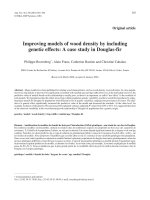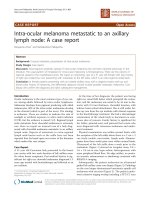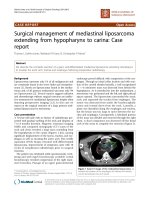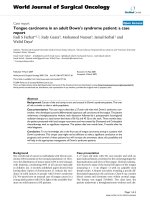báo cáo khoa học: " Successful treatment of metastatic hepatic epithelioid hemangioendothelioma with thalidomide: a case report" potx
Bạn đang xem bản rút gọn của tài liệu. Xem và tải ngay bản đầy đủ của tài liệu tại đây (860.04 KB, 4 trang )
CAS E REP O R T Open Access
Successful treatment of metastatic hepatic
epithelioid hemangioendothelioma with
thalidomide: a case report
Claire Raphael
1
, Emma Hudson
2
, Leslie Williams
3
, Jason F Lester
2
, Philip M Savage
1*
Abstract
Introduction: Hepatic epithelioid hemangioendothelioma is a rare malignancy arising from the vascular
endothelial cells within the liver. Historically, the disease is characterized as being poorly responsive to both
chemotherapy and radiotherapy, with liver resection or transplantation the treatment of choice when feasible. For
patients with advanced disease, reports of long-term ther apeutic benefits from conventional cytotoxic treatments
are very limited. Owing to the rarity of this malignancy, there is no structured therapeu tic research, but a small
number of cases have been reported to respond well to treatment with inhibitors of angiogenesis. Thalidomide
was originally developed as an anti-emetic but is a potent inhibitor of vascular neogenesis, and could offer
potential in the treatment of hepatic epithelioid hemangioendothelioma by blocking the proliferation of the
malignant vascular endothelial cells.
Case presentation: We describe the case of a Caucasian British woman who presented at the age of 53 years
with a hepatic mass, malignant lymphadenopathy and pulmonary metastases, which were confirmed as hepatic
epithelioid hemangioendothelioma on biopsy. After unproductive treatment with interferon, our patient was
started on thalidomide 400 mg daily. She has been successfully managed on this therapy for the past seven years,
and has remained asymptomatic, with radiologically stable disease and minimal treatment-related side effects.
Conclusion: At present, there is no standard therapy for advanced hepatic epithelioid hemangioendothelioma. Our
case supports the role for thalidomide and potentially other inhibitors of vascular neogenesis in the treatment of
patients with metastatic hepatic epithelioid hemangioendothelioma.
Introduction
Originally described in 19 82, hepatic epithelioid heman-
gioendothelioma (HEH) is a rare neoplasm arising from
the vascular endothelial cells of the liver [1] The inci-
dence is estimated at le ss than one case per million in
the population, with the diagnosis occurring across a
wide age range and with a male:female ratio of 2:3 [2-5].
The optimal management of patients with metastatic
disease is yet to be established. When the disease
remains confined to the liver, hepatic resection or
orthotopic liver transpl antation are the treatments of
choice [6]. Because of the rarity of the condition, the
effects of treatment are difficult to assess in a systematic
man ner but several case reports have described ben efits
for treatment with a range of therapies including che-
motherapy [7] an d interferon [8]. However, despite
these reported cases, HEH remains a difficult condition
to manage, without any apparent ro utine benefit from
various chemotherapy, immunotherapy or radiotherapy
approaches [3].
Thalidomide was first introduced as a treatment for
morning sickness in Europe in the 1950 s, but was
withdrawn after its severe teratogenic effects became
apparent [9]. More recently, the anti-vasculogenic,
immuno modulatory and anti-inflammatory properties of
thalidomide have shown clinical benefits in malignancies
including multiple myeloma, for which it is a licensed
therapy, and also in the experimental therapy of prostate
cancer and renal cell carcinoma [10].
* Correspondence:
1
Department of Medical Oncology, Charing Cross Hospital, Imperial College
Healthcare NHS Trust London W6 8RF, UK
Full list of author information is available at the end of the article
Raphael et al. Journal of Medical Case Reports 2010, 4:413
/>JOURNAL OF MEDICAL
CASE REPORTS
© 2010 Raphael et al; licensee BioMed Ce ntral Ltd. This is an Open Access article distributed under the terms of the Creative Commons
Attribution License ( which permi ts unrestricted use, distribution, and reproduction in
any medium, provid ed the original work is properly cited.
Current ly, data on the use of thalidomi de in the treat-
ment of HEH are limited to a small number of case
repo rts demonstrating significant clinical benefits for its
use either as monotherapy [11] or in combination with
other anti-angiogenic agents [12].
In this report, we describe a further case of HEH trea-
ted wit h thalidomide. The drug has proven to be
successful therapy for a patient with advanced metastatic
disease extending in excess of seven years, without sig-
nificant treatment-related toxicity.
Case presentation
A 53-year-old Caucasian British woman originally pre-
sented to her local hospital in 2002 with shortness of
breath secondary to atrial fibrillation. During the admis-
sion, c hest radiography revealed widespread pulmonary
nodular infiltrates, and a subsequent computed tomo-
graphy ( CT) scan confirmed the presen ce of widespread
pulmonary metastases, most marked in the lower lung
fields (Figure 1). The CT scan also demonstrated exten-
sive retroperitoneal and para-aortic lymphadenopathy
and hepatic abnormalities consistent with metastases,
but no obvious primary site for the disease (Figure 2).
Before admission, our patient had no symptoms of
liver dysfunction and her medical history was otherwise
unremarkable. She had no family history of malignancy.
Routine haematology, c lotting, serum biochemistry and
liver function tests, hepatitis screen and tumour markers
were all within normal limits. After the standard medi-
cal management for atrial fibrillation was completed, a
CT-guided biopsy of the predominant hepatic lesion
was performed.
Histological examination of the biopsy confirmed the
presence of an infiltrating tumour with pleomorphic
elongated cells that stained positively w ith the vascular
markers Factor VIII, CD31, and CD34. These morpholo-
gical and immunoh istochemical features were consistent
with the diagnosis of HEH. In the presence of dissemi-
nated disease, s urgical management was not indicated,
and our patient was referred to the oncology team for
ongoing management.
In response to radiologic al evidence of disease progres-
sion, first-line therapy with interferon was commenced in
accordance with the dosing recommendations published
in an earlier case report [8]. A CT scan performed after
three months therapy demonstrated stable disease; how-
ever, as our patient was experiencing significant inter-
feron-related side effects, the treatment was
discontinued. After a six-month break from therapy,
there was evidence of disea se progression within the
spleen seen on an updated CT scan, and the decision was
taken to explore treatment with thalidomide.
Starting initially at 100 mg per day, the dose of the
drug was increased at weekly intervals up to 400 mg.
Treatment was well tolerated and currently re mains at
400 mg daily, more tha n seven years later. During this
period, our patient has had regular restaging by CT
scans; the disease has remained stable in the lungs and
liver by Recist criteria, but with the development of cal-
cification within the predominant liver lesion (Figure 3
Figure 4). At present, our patient continues to have no
symptoms of the disease, and throughout the course of
treatment has not had any treatment-related toxicity
that has required either hospitalization or dose
reduction.
Conclusion
We report a case of metastatic HEH effectively treated
using thalidomide, To the best of our knowledge, this is
the third report to describe successful treatment of this
Figure 1 Computed tomography scan of the thorax performed
at presentation in 2002 demonstrating multiple pulmonary
metastases.
Figure 2 Abdominal computed tomography scan f rom 2002
showing a large tumour in the liver that was confirmed on
biopsy as hepatic epithelioid hemangioendothelioma
Raphael et al. Journal of Medical Case Reports 2010, 4:413
/>Page 2 of 4
rare disease using this agent. In contrast to an earlier
report [11], w e did not find any major reduction in dis-
ease bulk with t halidomide treatment; however, our
patient has remained clinically and radiologically stable
over a period in excess of seven years. More recently,
the case of a patient treated with lenalidomide, a deriva-
tive of thalidomide, has been described, reporting long-
term benefit in a patient with HEH progressing aft er
earlier chemotherapy treatment [13].
Although the evidence in support for treatment of
metastatic HEH with thalidomid e or lenalidomide is
limited to case reports, it is unlikely, because of the
rarity of this condition, that any fo rmally structured
clinical research can readily be performed. This apparent
activity combined with the modest side-effect profile of
thalidomide or lenalidomide, and the lack of any other
standard therapy m akes a strong case for considering
these drugs as first-line therapy of metastatic HEH.
In summary, we successfully used thalidomide in the
treatment of HEH with widespread pulmonary, hepatic
and retroperitoneal metastases, with stable disease after
seven years of follow-up. Thalidomide is a low toxicity
agent that a cts as an inhibitor of vascular neogenesis,
and seems both an intuitive and clinically supported
choice of agent for treatment of this malignancy when
surgical management is not appropriate.
Consent
Written informed consent was obtained from the patient
for publicatio n of this case report and any accompany-
ing images. A copy of the written consent is available
for review by the Editor-in-Chief of this journal.
Author details
1
Department of Medical Oncology, Charing Cross Hospital, Imperial College
Healthcare NHS Trust London W6 8RF, UK.
2
Department of Clinical
Oncology, Velindre Hospital, Cardiff CF14 2TL, UK.
3
Department of Radiology,
Velindre Hospital, Cardiff CF14 2TL, UK.
Authors’ contributions
All the authors have read and approved the final version of this manuscript.
CR, EH and PS assembled the clinical data and wrote the paper. EH, LW, JL
and PS were involved in the clinical care. PS is the corresponding author.
Competing interests
The authors declare that they have no competing interests
Received: 30 March 2010 Accepted: 22 December 2010
Published: 22 December 2010
References
1. Weiss SW, Enzinger FM, Epitheloid hemangioendothelioma: A vascular
tumor often mistaken for a carcinoma. Cancer 1982, 50:970-81.
2. Ishak KG, Sesterhenn IA, Goodman ZD, Rabin L, Stromeyer FW: Epithelioid
hemangioendothelioma of the liver: a clinicopathologic and follow-up
study of 32 cases. Hum Pathol 1984, 15:839-852.
3. Makhlouf HR, Ishak KG, Goodman ZD: Epithelioid hemangioendothelioma
of the liver: a clinicopathologic study of 137 cases. Cancer 1999,
85:562-582.
4. Hertl M, Cosimi AB: Liver transplantation for malignancy. Oncologist 2005,
10:269-81.
5. Mehrabi A, Kashfi A, Fonouni H, Schemmer P, Schmied BM, Hallscheidt P,
Schirmacher P, Weitz J, Friess H, Buchler MW, Schmidt J: Primary malignant
hepatic epithelioid hemangioendothelioma: a comprehensive review of
the literature with emphasis on the surgical therapy. Cancer 2006,
107:2108-21.
6. Lerut JP, Orlando G, Adam R, Schiavo M, Klempnauer J, Mirza D,
Boleslawski E, Burroughs A, Sellés CF, Jaeck D, Pfitzmann R, Salizzoni M,
Söderdahl G, Steininger R, Wettergren A, Mazzaferro V, Le Treut YP,
Karam V, European Liver Transplant Registry: The Place of liver
transplantation in the treatment of hepatic epitheloid
hemangioendothelioma: report of the European Liver Transplant
Registry. Ann Surg 2007, 246:949-957.
7. Idilman R, Dokmeci A, Beyler AR, Bastemir M, Ormeci N, Aras N, Ekinci C,
Uzunalimoglu O, De Maria N, Van Thiel DH: Successful medical treatment
of an epithelioid hemangioendothelioma of liver. Oncology 1997,
54:171-5.
8. Roudier-Pujol C, Enjolras O, Lacronique J, Guillemette J, Herbreteau D,
Leibowitch M, Escande JP: Multifocal epithelioid hemangioendothelioma
Figure 3 Computed tomography scan of the thorax performed
after seven years of treatment showing the lack of any
significant disease progression during thalidomide therapy.
Figure 4 Computed tomography scan of the abdomen
performed in 2009 demonstrating an unchanged size of the
liver lesion over the seven-year period but with the
development of calcification.
Raphael et al. Journal of Medical Case Reports 2010, 4:413
/>Page 3 of 4
with partial remission after interferon alfa-2a treatment. Ann Dermatol
Venereol 1994, 121:898-904.
9. McBride WG: Thalidomide and congenital abnormalities. Lancet 1961,
2:1358,.
10. Eisen T: Thalidomide in solid malignancies. J Clin Oncol 2002,
20:2607-2609.
11. Mascarenhas RC, Sanghvi AN, Friedlander L, Geyer SJ, Beasley HS, Van
Thiel DH: Thalidomide inhibits the growth and progression of hepatic
epithelioid hemangioendothelioma. Oncology 2004, 471-475.
12. Kassam A, Mandel K: Metastatic hepatic epithelioid
hemangioendothelioma in a teenage girl. J Pediatr Hematol Oncol 2008,
30:550-552.
13. Sumrall A, Fredericks R, Berthold A, Shumaker G: Lenalidomide stops
progression of multifocal epithelioid hemangioendothelioma including
intracranial disease. J Neurooncol 2010, 97:275-277.
doi:10.1186/1752-1947-4-413
Cite this article as: Raphael et al.: Successful treatment of metastatic
hepatic epithelioid hemangioendothelioma with thalidomide: a case
report. Journal of Medical Case Reports 2010 4:413.
Submit your next manuscript to BioMed Central
and take full advantage of:
• Convenient online submission
• Thorough peer review
• No space constraints or color figure charges
• Immediate publication on acceptance
• Inclusion in PubMed, CAS, Scopus and Google Scholar
• Research which is freely available for redistribution
Submit your manuscript at
www.biomedcentral.com/submit
Raphael et al. Journal of Medical Case Reports 2010, 4:413
/>Page 4 of 4









